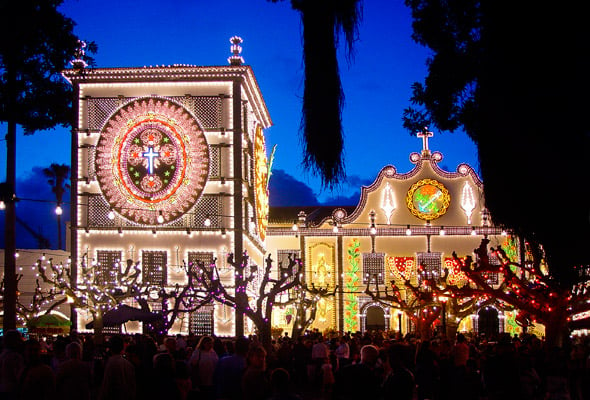
“I bet no one knows pirates had a hand in this,” my friend Ana Maria Albuquerque Taveira said of the glut of religious pilgrims squeezing by us. Her arm was flung over the railing of the tasquinha, one of dozens of jerry-rigged food stalls that residents of Ponta Delgada, the capital of the Azorean island of São Miguel, had set up for the Festa do Senhor Santo Cristo dos Milagres.
Every year, the usually circumspect islanders grow festive during the event, held on the fifth Sunday after Easter. Throughout that week, the city turns inside out like a glove as everyone from grandmothers to restaurateurs, normally content to cook inside, pour out into the streets to hawk their food to an equally enthusiastic audience. Growing up in Fall River, Massachusetts, one of America’s biggest Little Azores, I took part in countless religious festivals. Still, I wanted to experience this one, which has as its centerpiece a life-size bust of Christ purported to perform miracles, for no other festa offers such unself-conscious pageantry, solemnity, and, glitz.
As Ana continued to survey the scene, her husband, Filipe, and I made short work of a plate of fava rica, broad beans gently simmered with garlic, onion, pepper paste, and a touch of cinnamon — which lent a welcome sweetness to a familiar dish.
“Good, aren’t they? Ana asked. I nodded. “Of course they are!” she added, as if any other response would be absurd.
Avenida Roberto Ivens, where we sat eating around a small plastic table, was hung low with swags of lights in a riot of colors and shapes. The smell of grilling chouriço sausage wafted across in great gusts of blue smoke. On the ground, tubs of crabs and limpets, a gastropod so beloved that they’re in danger of being over-harvested, lined the street. In the tasquinhas stood the cooks, some sawing huge loaves of corn bread or stirring vats of tripe, others beckoning passersby with a piece of food stuck on the business end of a serving fork. Most of the crowd comes to worship, but despite best intentions, the corporeal often trounces the spiritual, which is why the tasquinhas, and not the churches, are filled nearly round the clock.
Nonetheless, the festa has been a touchstone of Azorean Catholicism for more than 300 years. In 1540 an order of nuns settled into the Convento de Nossa Senhora da Esperança in Ponta Delgada after being driven from a smaller coastal convent by the pirates Ana delighted in telling me about.
The nuns lived an unremarkable life until Teresa da Anunciada joined the order in 1683. She was charged with caring for the chapel in which the statute, a gift from a pope who three centuries earlier had granted the license to establish the original convent, sat neglected. Soon after, parishioners who prayed to the icon reported experiencing miracles, news that ignited a religious fervor that still burns white-hot. Sometime between 1698 and 1700, Teresa organized a procession around the praça outside the convent to satisfy the growing number of worshippers eager to see and pray to the statue. This humble march grew to become the second-largest religious procession in the world and now takes most of the afternoon to course though downtown Ponta Delgada.
The original convent, I was stunned to discover, was bought by Ana’s ancestor António Manuel de Medeiros da Costa Canto e Albuquerque in 1854, when the Vatican was ridding itself of cumbersome real-estate holdings, and is still in her family.
“Wait here,” Ana said. Filipe and I watched her make a reconnaissance loop through the street, interrupting her mission to greet neighbors, direct lost tourists, and chide returning friends who hadn’t looked her up since last year’s festa. No wonder Filipe is fond of calling her “the unofficial mayor of Ponta Delgada.”
She eventually returned with her arms laden with paper plates and plastic containers filled with food. What she couldn’t carry, she entrusted to one of the sons of a fishmonger. We made a meal of more fava rica; polvo, garlicky stewed octopus; grilled lapas smothered in musky olive oil, lemon, and parsley; dobrada com feijão, tripe simmered with white beans and sausage; rissóis de carne, deep-fried turnovers filled with a spicy beef mixture; and chouriço à bombeiro, “fireman’s sausage” that was doused with aguardente, a potent distilled spirit, and then lit on fire. Another trip brought a steaming container of caracóis, small, tan snails; a pile of pastéis de bacalhau, or codfish balls made from potatoes, dried cod, onion, and parsley; and hard-boiled eggs coated in a pepper paste. It was all washed down with beer; Portugal’s famous, slightly effervescent white wine, vinho verde; and vinho de cheiro, cheap red wine that’s meant to be drunk the same year it’s pressed.
“Come,” Ana said, leading us down to the harbor. I looked at Filipe, and we laughed. Ana knew I was here to experience everything about the festa, and she wasn’t about to disappoint.
We entered a massive tent, which gathered the entire dock under its flaps, and I could smell them immediately. I needed no interpreter or directions to find them. Malassadas are deep-fried, sugar-coated fritters practically the size of lunch plates. It had been years since I’d had them, especially warm from my grandmother’s black cast-iron skillet. We ordered some and ate them to the sound of fado, the plaintive music said to express the loss and longing of the Portuguese. The sugar sloughed off onto my shirt, as it did when I was seven. And I cared about it as much as I did back then.
Ana looked at her watch. It was past one a.m. “Bastante?” Had enough?
“Until tomorrow,” I said.
The food and Ana’s energy continued unabated the next afternoon. She and Filipe had invited me to watch the procession from their home, which is along the route. When I arrived she had already set the table buffet-style. Within minutes, the bell rang, and a crowd of family, friends, and some of the Americans she had reprimanded the night before gathered in the dining room and closed ranks around the table.
Because it was after lunch, Ana had laid out few savories — a simple carne assada, grilled octopus, some mini chouriço rolls, and a selection of local cheeses: Queijo de Ilha, a piquant semi-hard cheese that comes from São Miguel, and Queijo São Jorge, a famous Cheddar-like cheese from the nearby island of the same name.
The mainstay of the table, though, was sweets. The Portuguese, owing to years of Moorish occupation, developed a passion for egg desserts that borders on the insatiable, and Ana’s table seemed to bow under the weight of them. There was rice pudding topped with cinnamon. Platters of pastéis, or pastries, were wedged between the cooling main courses. Pastéis de nata, without a doubt the most popular, are filled with baked custard; Ana also had the almond and coconut versions. And room was made for the flans, puddings, and trifles guests brought as hostess gifts.
The dining room grew loud and overheated, so I claimed my spot on one of Ana’s two wrought-iron balconies. Below families were laying down large wooden frames and filling the geometric sections with neon-colored wood shavings and greens clipped from nearby trees to create a soft carpet for the devout to walk on. Old women were settling into chairs dragged from their kitchens. Their mouths moved silently as their rosaries bobbled in their hands. Across the way, Persian rugs were being flopped over balcony railings. Color, it seemed, was the order of the day.
The pounding of a bass drum announced the procession, and a phalanx of men in dark suits and red smocks led the way. Among them was Filipe. He was part of the Irmandade do Senhor Santo Cristo dos Milagres, a fraternal organization charged with planning and executing the annual procession. Behind them were hours’ worth of school groups, organizations, wheezing bands from different villages, and pilgrims from nearly every former Portuguese colony.
Finally the statue, held aloft on a litter, came into view. It wore one of its 25 red capes, which was heavy with jewels that worshippers — many of them peasants — had offered as a show of thanks or adulation. Its halo, crown, scepter, cordons, and pendant, which contains a piece of wood said to have come from Christ’s cross, were forged from the finest Portuguese gold and encrusted with thousands of precious gems. I ignored the rantings of my inner recovering Catholic, but the fact that Europe’s poorest country owns one of the world’s most valuable religious relics wasn’t lost on me — just one of the jewels in the statue’s treasury was valued at 12 million euros.
Behind the icon walked the women and families. “What are those?” I asked Ana, pointing to several women holding bundles of tall, unlit church candles in their arms. Some of the bundles slumped like sleeping babies because the sun and the warmth of the women’s bodies had softened the wax. She explained that many worshippers who have experienced miracles in their lives choose to carry these as a public thank you to God. I looked down the street: Countless bouquets of candles bobbed in the women’s arms.
Long after the procession had passed, I returned to the balcony. The carefully laid carpet had been scattered, and all that remained were a few fronds stuck between the chipped cobblestones like hayseed sticking out from a row of bad teeth.
Ana came over. “Bastante?”
I laughed. It was clear she wouldn’t be happy until I was. “Sim.”
“Good,” she said and returned to her dining room, which was wedged with a new group of hungry guests.


















Hello David,
Thanks for this story. I’m headed (back) to Sao Miguel after many years away and wondered if your restaurant recommendations still apply, or if you have any new intel on where to eat on Sao Miguel. All best, Anne (from Toronto)
Anne, you’re more than welcome. At last check, they were still good, but that was before COVID. And, of course, that changed everything. I hope you enjoy your trip, and if you discover some new places, let me know!
I LOVED this festa when I was a little girl. I too walked and played music for the Filarmónica do Santo António, Cambridge, MA. There is this pão that I am trying to figure out the name of, but it has slipped my mind. LOVE mass. Love being PORTUGUESE, and love how cool our culture is.
Amanda, agreed on all counts. Is the bread you’re trying to think of called papos secos? Or the sweet, eggy bread massa souvada?